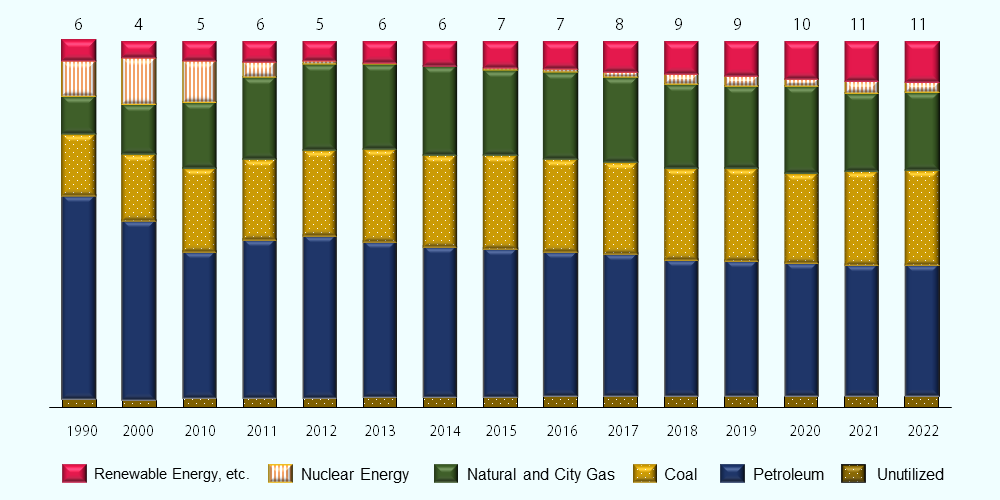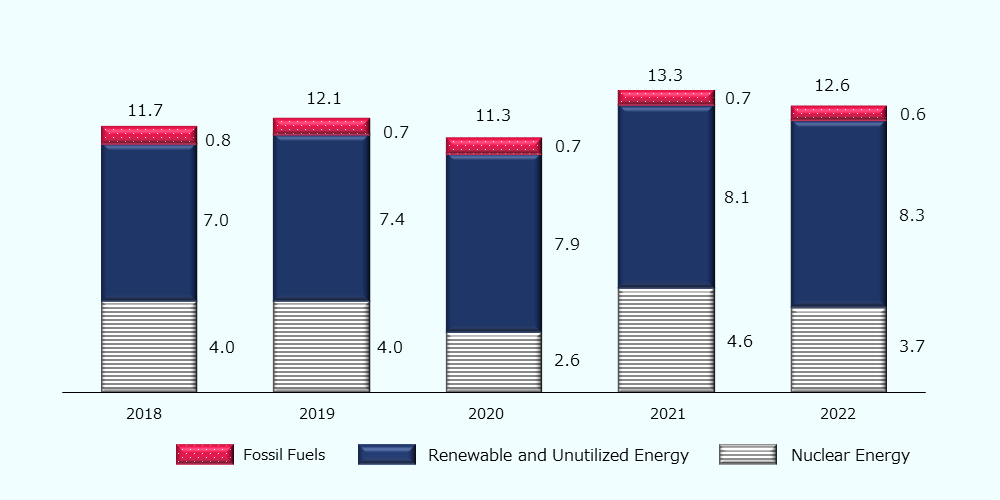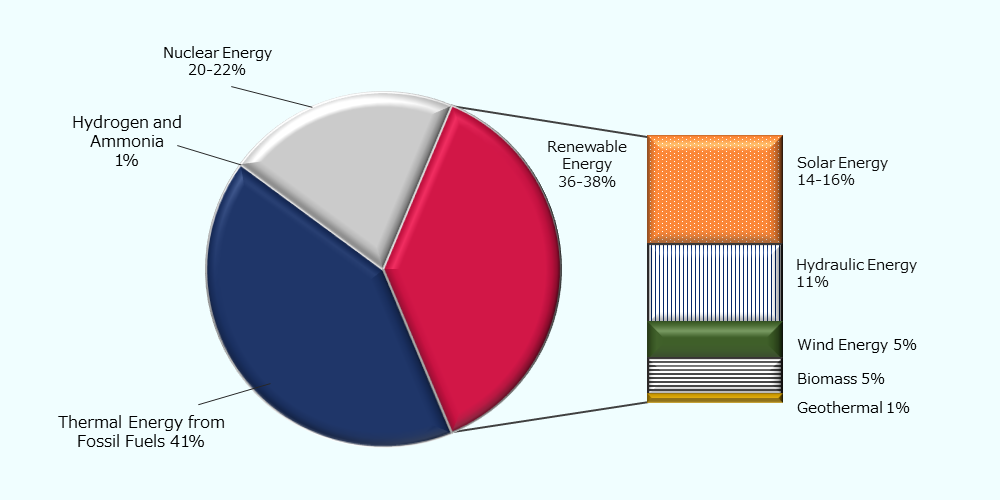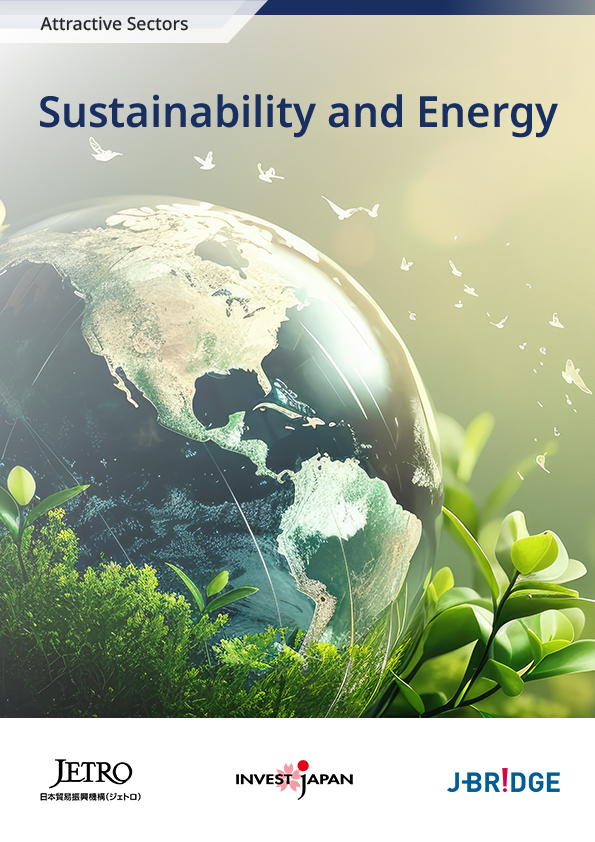-
(1)
Establishment of a basic policy for achieving green transformation
-
(2)
Introduction of FIT and FIP schemes
-
(3)
Implementation of Electricity System Reform
-
(4)
Initiatives by local government agencies (Zero Carbon Cities)
Sustainability and Energy
Overview

Promoting Renewable Energy to Achieve Stable Energy Self-Sufficiency and Carbon Neutrality
The recent global situation has led to a sharp rise in energy prices. In the first half of 2022, JKM (Asian LNG spot price), TTF (Dutch gas price), and NBP (UK gas price) prices for crude oil, natural gas, etc. reached a global record high of 84.8 USD, 99.5 USD, and 70.4 USD, respectively1.
In addition, the global trend towards de-carbonization, including the Paris Agreement, has led to increasing interest in self-sufficient and renewable energy in Japan.
Renewable energy accounted for 11% of domestic energy supply composition in 2022 and it has been increasing steadily (Figure 1). Furthermore, the energy self-sufficiency rate in 2022 was 12.6%, with renewable energy sources accounting for 8.3%, and the proportion is on an increasing trend (Figure 2).
Figure 1: Trends in source composition of primary energy supply in Japan (%)

Source: Created by JETRO based on data from ANRE 2
Figure 2: Trends in energy self-sufficiency rate and composition of its contribution (%)

Source: Created by JETRO based on data from ANRE3
In 2020, the Japanese government announced Carbon Neutrality, and consequently, the Ministry of Economy, Trade and Industry (METI) formulated the Green Growth Strategy. The strategy identified four energy-related sectors with growth potential: (i) offshore wind energy, solar, and geothermal energy; (ii) hydrogen and fuel ammonia; (iii) next-generation thermal energy; and (iv) nuclear energy4.
Furthermore, the energy composition target for 2030 aims for a 36–38% share of renewable energy sources, with target figures identified for solar, hydro, wind, biomass, and geothermal. (Figure 3).
Figure 3: Energy composition targets for FY2030

Source: Created by JETRO based on data from METI5
-
*
Calculated based on the Bank of Japan exchange rate of 1 USD at 150.07 JPY (as of March 1, 2024)
References
- Agency for Natural Resources and Energy. Energy White Paper 2023, Part 1, Chapter 1, Section 1 (JP).
- Agency for Natural Resources and Energy. "Primary Energy Supply Rate in Japan," Comprehensive Energy Statistics (JP), time-series table (published on November 29, 2023).
- See Note 2, "Energy Self-Sufficiency Rate."
- METI. Green Growth Strategy Through Achieving Carbon Neutrality in 2050.
- Agency for Natural Resources and Energy. Renewable Energy Policies for the Future (JP), p. 5.
-
Government Initiatives
Strengthening Market Competitiveness in Green Transformation and Energy to Achieve De-carbonization, Stable Energy Supply, and Economic Growth

-
Attractive Markets
We Focus on Following Five Attractive Markets With Growth Potential in the Environment & Energy Industry.
-
(1)
Offshore wind energy: Active market entry by foreign companies
-
(2)
Biomass: Advancing institutional development in terms of costs
-
(3)
Solar energy: The largest renewable energy source in Japan
-
(4)
Hydrogen: World-leading R&D and implementation
-
(5)
Storage batteries (lithium-ion): Diverse commercialization and international collaboration

-
Sustainability and Energy Report

You can download the whole report on the webpage free of charge. Please simply fill out the form below to get information on promising industries in the Japanese market. Download now and use the information for your success in business.
-
- Business Expanding
- Sustainability & Energy
- Singapore
Singaporean Cleantech Startup uHoo Establishes Japan Subsidiary - Promoting "Visible" Indoor Air Quality through Smart Sensing Technology -
-
- Business Expanding
- Other
- Sustainability & Energy
- Singapore
Singapore-based agritech company Arianetech has established a business base for its Japanese subsidiary
-
- Business Expanding
- Sustainability & Energy
- China
Das Solar engaging in research & development, manufacturing, and sales of photovoltaic cells and modules establishes a subsidiary in Tokyo
Contact Us
Investing in and collaborating with Japan
We will do our very best to support your business expansion into and within Japan as well as business collaboration with Japanese companies. Please feel free to contact us via the form below for any inquiries.
Inquiry FormJETRO Worldwide
Our network covers over 50 countries worldwide. You can contact us at one of our local offices near you for consultation.
Worldwide Offices



























